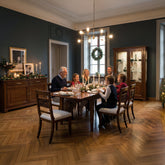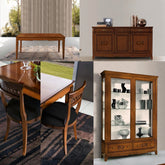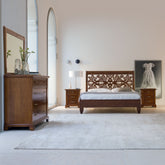Best-selling products
Complete Dining Room Walnut and Leather Modigliani
- From €14.690,00
€25.463,00- From €14.690,00
- Unit price
- / per
- From €14.690,00
€25.463,00- From €14.690,00
- Unit price
- / per
Classic Cherry Dining Room with Art Inlays
- From €11.690,00
€19.157,00- From €11.690,00
- Unit price
- / per
- From €11.690,00
€19.157,00- From €11.690,00
- Unit price
- / per
Complete Classic Dining Room in D'Este Cherry Wood
- From €7.990,00
€12.875,00- From €7.990,00
- Unit price
- / per
- From €7.990,00
€12.875,00- From €7.990,00
- Unit price
- / per
Camera Set Classic Double Bedroom Complete in Inlaid Cherry Wood Art
- From €11.590,00
€19.469,00- From €11.590,00
- Unit price
- / per
- From €11.590,00
€19.469,00- From €11.590,00
- Unit price
- / per
History of Piombini Furniture: Wood, Design, and Craft Passion for 100 Years
CHAPTER 1
Thanks to Mario Piombini...
Mario Piombini and the first furniture company.
Mario Piombini was born in 1897 in Bovolone to a very poor family living in Corte Quaranta (roughly where the kindergarten now stands, between Via Roma and Via Ospedale), and he learned the trade of a carpenter. After serving in the military from 1917 to '19, during which he took part in the events of the Great War, he started working as a joiner and married Rosa Bruna Zanini, with whom he had his first daughter, Pierina, who unfortunately died at 18 months old; this loss was offset by the birth of Bruno on January 1, 1925. In 1927 Renato was born, and the following year another daughter came into the world, who was given the same name as the first girl; the last child, Giorgio, would be born ten years later.

- From €6.790,00
€10.612,00- From €6.790,00
- Unit price
- / per
- From €3.290,00
€6.481,00- From €3.290,00
- Unit price
- / per
- From €2.190,00
€4.220,00- From €2.190,00
- Unit price
- / per
- From €2.980,00
€5.832,00- From €2.980,00
- Unit price
- / per
- From €3.680,00
€7.190,00- From €3.680,00
- Unit price
- / per
- From €3.510,00
€6.786,00- From €3.510,00
- Unit price
- / per
- From €2.490,00
€4.806,00- From €2.490,00
- Unit price
- / per
- From €3.290,00
€6.517,00- From €3.290,00
- Unit price
- / per
- From €14.181,00
€14.181,00- From €14.181,00
- Unit price
- / per
- From €3.790,00
€6.039,00- From €3.790,00
- Unit price
- / per
- From €2.990,00
€5.121,00- From €2.990,00
- Unit price
- / per
- From €3.149,00
€6.088,00- From €3.149,00
- Unit price
- / per
- From €2.490,00
€4.562,00- From €2.490,00
- Unit price
- / per
- From €2.370,00
€4.593,00- From €2.370,00
- Unit price
- / per
- From €3.090,00
€5.957,00- From €3.090,00
- Unit price
- / per
In 1925 Mario partnered with his friend Amedeo Santolini, founding with him the first furniture company, initially housed in a wooden shack in the field behind their home, where the Hospital now stands. The Piombini-Santolini company performed well, so much so that about ten years later, it earned the gold medal at the Turin Exhibition, and the diploma certifying that recognition is still proudly displayed at the current company headquarters.
CHAPTER 2
The first furniture shops in Bovolone. (Circa 1930s-40s)
Among the people from Bovolone who learned the art of furniture making in Asparetto from Giuseppe Merlin, we remember Mario Carmagnani, Giuseppe Perazzani, Mario Pettene called Coco, Tullio Vedovelli called Napa, Giuseppe Masaia, Giobatta Pantano, Remo Guarnieri called Tamao, Giuseppe Padovani called Braghin. Already in 1930, Pantano, along with Padovani, Carmagnani, and the seventeen-year-old Liberale Vaccari called Lale, who was already a student of Grella, opened their own workshop in Bovolone; in '34 the group disbanded and Vaccari partnered with Gino Veronesi (called Muci), who had also attended Merlin's workshop but later, like Leonello (Nelo) Vicentini: in that workshop worked Giglio Mariotto (S'cinco), Raffaello Morellato, and Vittore Novarini. Later, Pantano, as a young apprentice of Antonio Grella, opened a workshop at Persegarol which was then continued by his sons, Padovani set up a workshop at Madonna with Novarini and a certain Peroni, while the aforementioned Guarnieri later ran a tobacco shop and then opened a hardware store in Verona. Some of the aforementioned also worked, for some time, at the largest workshop with the most employees, even before the war, that of Nello Vicentini (initially a partner of Giuseppe Olfi) at Casella, which had among its workers Severino Cantiero, Giuseppe (Вері) Mirandola, and other excellent carpenters; at Vicentini's also worked the mentioned Vedovelli, who became an expert polisher, and Veronesi, who later went independent to build white curved furniture. They built chairs in the style of Gino Sargenti, the aforementioned Perazzani, and Vittorino Carmagnani..
The other workshop with the highest number of employees was that of Mario Piombini, which was not in competition with the first ones because it manufactured modern furniture; even before the war, it had been equipped with a large band saw and a seven-function planer, which were sometimes also used by some cabinetmakers of classic-style furniture to whom he had granted the use of the large room above the workshop.
The Piombini company sold its products locally to private customers but above all to Italian retailers such as Picasso of Genoa or Paolucci of Pesaro, also through salesmen like Pompilio Zavanella of Nogara, a former student of Merlin in Asparetto.
The relationship with the latter was one of active collaboration, because the company from Bovolone supplied him with modern furniture with which Merlin replaced, in many homes, the antique furniture he purchased; on the other hand, Piombini resold to Merlin any old or antique furniture he took in when selling the modern pieces.
The business was now fully underway, and in Bovolone it could rely on two fairly well-stocked timber dealers (Zago and Bertolazzi), although the international sanctions imposed on Italy had limited the choice to national woods and substitutes like plywood and blockboard, while for the various types of products the corresponding wood species and the label certifying the use of "autarkic wood" were required. The war events led to the dissolution of the Piombini-Santolini company, and Mario Piombini continued the business alone, assisted by his sons Bruno and Renato: he was too old to return as a soldier, and they were still too young to be called to arms. Finally, Bruno was ordered by the Germans of the O.T. (Organisation Todt) to work first on the large anti-tank ditch at Caltrane, then at Montorio, where he occasionally had his brother substitute for him for a few days. In the workshop, activity was languishing (the saw and plane had been buried to avoid being requisitioned); during the chaotic phases of the retreat, Mario was wounded in the side by a shot fired by the Germans: his transport to the hospital, which was less than a hundred meters away, was very laborious and quite dangerous, taking the disproportionate time of an hour and a half.

- From €6.790,00
€10.612,00- From €6.790,00
- Unit price
- / per
- From €3.290,00
€6.481,00- From €3.290,00
- Unit price
- / per
- From €2.190,00
€4.220,00- From €2.190,00
- Unit price
- / per
- From €2.980,00
€5.832,00- From €2.980,00
- Unit price
- / per
- From €3.680,00
€7.190,00- From €3.680,00
- Unit price
- / per
- From €3.510,00
€6.786,00- From €3.510,00
- Unit price
- / per
- From €2.490,00
€4.806,00- From €2.490,00
- Unit price
- / per
- From €3.290,00
€6.517,00- From €3.290,00
- Unit price
- / per
- From €14.181,00
€14.181,00- From €14.181,00
- Unit price
- / per
- From €3.790,00
€6.039,00- From €3.790,00
- Unit price
- / per
- From €2.990,00
€5.121,00- From €2.990,00
- Unit price
- / per
- From €3.149,00
€6.088,00- From €3.149,00
- Unit price
- / per
- From €2.490,00
€4.562,00- From €2.490,00
- Unit price
- / per
- From €2.370,00
€4.593,00- From €2.370,00
- Unit price
- / per
- From €3.090,00
€5.957,00- From €3.090,00
- Unit price
- / per
CHAPTER 3
The Roots of Artistic Furniture
The vision of Mario Piombini
After the end of the war, in an Italy that was beginning to breathe again, Mario Piombini was among the few artisans in the area to participate in the furniture exhibition held in Verona, at the Palazzo del Mutilato. It was from there that a new idea began to take shape: to create a furniture art capable of combining elegance, memory, and innovation.
He moved his company first to the district of Pozza, then to Via Carlo Alberto — where Piombini once had a showroom that for years was a point of reference for artisanal elegance, and which for a very long time was also the family home.
There he understood the value that could arise from the union between artisanal tradition and commercial vision.
The insight: the “exhibition” and the first catalog
In the late 1940s, Mario made two pioneering moves: he created the first "exhibition" of art furniture on Via Madonna, and printed a real catalog to be distributed through representatives and retailers.
That catalog, now a valuable document, contained as many as 108 models, some produced in-house, others selected from the best workshops in Bovolone and Cerea. Baroque, Venetian rococo, neoclassical, Maggiolini styles, but also Renaissance and English, with refined inlays, fine veneers, and a skillful use of noble materials.
A knowledge passed down, a shared passion, an identity that already looked abroad: the catalog was in three languages, and the first exports to Switzerland and Germany began between 1947 and 1950.
The moral legacy of Roberto Piombini
The book published to celebrate 75 years of activity was not the story of a man, but the story of a land.
Roberto Piombini, with the heart and intelligence of one who has known how to preserve and innovate, did not want to put himself at the center. He chose to give voice to the territory, the family, the work, celebrating values that transcend time.
This spirit of humility and greatness is one of the most special and distinctive qualities of the man Roberto Piombini — and it still guides us today, in every piece of furniture born from our hands.
The Heart of the Tradition of Veronese Artisans
For 100 years, everything has been born from the skilled hands of Veronese artisans, who with passion and precision bring timeless furniture to life. Each piece tells a story made of worked wood, hand-painted, and carefully protected, ready to reach the heart of your home. We select only what best represents our tradition, the craftsmanship that has distinguished and made us unique for generations. Here is a selection of some products to celebrate with Piombini customers.
- From €6.790,00
€10.612,00- From €6.790,00
- Unit price
- / per
- From €3.290,00
€6.481,00- From €3.290,00
- Unit price
- / per
- From €2.190,00
€4.220,00- From €2.190,00
- Unit price
- / per
- From €2.980,00
€5.832,00- From €2.980,00
- Unit price
- / per
- From €3.680,00
€7.190,00- From €3.680,00
- Unit price
- / per
- From €3.510,00
€6.786,00- From €3.510,00
- Unit price
- / per
- From €2.490,00
€4.806,00- From €2.490,00
- Unit price
- / per
- From €3.290,00
€6.517,00- From €3.290,00
- Unit price
- / per
- From €14.181,00
€14.181,00- From €14.181,00
- Unit price
- / per
- From €3.790,00
€6.039,00- From €3.790,00
- Unit price
- / per
- From €2.990,00
€5.121,00- From €2.990,00
- Unit price
- / per
- From €3.149,00
€6.088,00- From €3.149,00
- Unit price
- / per
- From €2.490,00
€4.562,00- From €2.490,00
- Unit price
- / per
- From €2.370,00
€4.593,00- From €2.370,00
- Unit price
- / per
- From €3.090,00
€5.957,00- From €3.090,00
- Unit price
- / per
Our customers' opinions
- Choosing a selection results in a full page refresh.






















